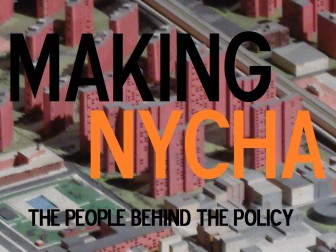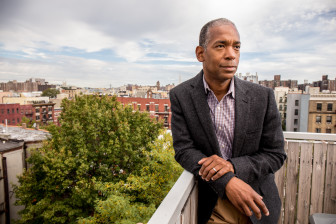
William Alatriste for the New York City Council
Ritchie Torres has embraced plans to develop NYCHA land and convert some public housing to Section 8.
When Ritchie Torres presides over a City Council hearing, the room is his. Everything you would expect to count against the Councilmember of the Bronx’s 15th District, like his extreme youth (he’s the youngest City Councilmember at 27), or the fact that he dropped out of college, or that he grew up in a milieu very different from those around him, falls away in the face of his convictions. He is in his element, a place where his intellectual confidence and verbal acuity command attention.
“I worry about the unaccountable exercise of power,” Torres told me recently, when we met at a café near City Hall. “And the beauty of a City Council hearing oversight is that it makes power more accountable.”
In person, Torres is less self-possessed. His quirks—a certain shyness, an absolute resistance to being interrupted or to changing the subject before he’s ready—reassert themselves around the edges of his eloquence. He sometimes seems to be recalibrating, despite intense and insistent eye contact and cut-from-marble cheekbones.
“Socially, I can be awkward at times,” he admitted, quick to spin the confession into a barb. “I’m not as gifted a retail politician as others might be.” This awkwardness vis a vis his chosen profession goes beyond politicking. “I dread attending the galas and the cocktail parties because I’m just so different from the people there,” he said. “My view of life, my experience of life, is so different from theirs. Even though I project a smile, I’ll engage in the usual schmoozing, at some level I do feel alienated.”
But it’s precisely the experiences that distinguish Torres from others in City Hall—experiences like growing up gay in public housing in the Bronx, or like being constantly, devastatingly, underestimated by white teachers and students—that implanted within the young politician the qualities that color his leadership as Councilmember and Chair of the Committee on Public Housing.
Second in a series of three
For Torres supports some controversial measures. He has come out in support of Infill—the plan to develop public-housing land in order to generate revenue for the cash-strapped authority. He also supports Rental Assistance Demonstration (RAD), a federal program that converts public housing into Section 8, another kind of subsidized housing in which the resident receives a voucher to live in private housing. Many public-housing residents, resident advocates, and even elected officials oppose these measures on the grounds that they represent the end of public housing, or at least, the first steps towards its privatization. Not Torres.
He casts his position as pragmatism. “In some sense, market-rate development on public land creates a visual tale of two cities,” he allowed. “It reminds us of what is wrong with our society. But no one is promoting infill as a public good,” he insisted more than once. “It is a tragic necessity in a world of federal disinvestment from public housing. If the federal government is no longer going to remain in the business of supporting and investing in public housing, we need to generate revenue by other means, and one of those means is building on public land.”
Coping with tragic necessities—surviving, despite the challenges posed by life, is not only a professional ideology that Torres espouses and that distinguishes him from his colleagues. It is part and parcel of his personal journey. Ritchie Torres is a survivor, and it is this personal narrative that fuels not just his deep commitment to the survival of public housing, but a certain lack of sentimentality when it comes to qualms about the choices NYCHA is making.
When asked how he would respond to allegations of privatization, he answered in classic Torres fashion, without missing a beat. “So what?” he said. “The objective is to provide a deep affordability to the poorest New Yorkers in our city, so they can live here. How we do that is irrelevant. Maybe I’m wrong. But as long as the residents are only paying 30 percent of their gross adjusted income, why would you care how it’s financed?”
Torres grew up in a single-mother home in the New York City Housing Authority (NYCHA) Throggs Neck Houses in the Bronx, an apartment that Torres told City Limits in 2013 was plagued by vermin and a leaky roof.
But when we spoke recently, Torres spoke of his childhood home differently. “I enjoyed it,” he told me of growing up in NYCHA. “I have fond memories of it. I loved the recreational life, Throggs Neck Houses, wrestling in the park.” Yes, there were struggles to get repairs; yes, there was violence in the neighborhood. But public housing gave the family stability, too, he said. Torres’s stepfather abandoned the family when Torres was 12, and Torres says that had the family been living in a private apartment, they would have been homeless. “Because we were in public housing we were able to cling on to our home,” he said. “I would not be where I am today without the New York City Housing Authority.”
Without a father figure, Torres says he was raised by three women—his mother, grandmother, and sister. “So when I think leadership, I think women,” he said. “Women are natural leaders in my mind, whereas men had been disappointments.”
Torres first realized he was gay in middle school. “I was a fan of professional wrestling,” he said. “I confess I would impersonate and had a crush on the Rock.” Being a gay teenager in the Bronx was not easy. “I was careful to keep my homosexuality to myself for fear of violence and rejection, growing up in the projects, growing up in the Bronx,” he said. “I remember the first time I went to the village, I was shocked to see two men holding hands. That’s an image I could never imagine in the Bronx, even today.”

William Alatriste
Torres getting arrested at a 2014 protest by airport workers seeking better working conditions. He quickly gained power in the Council after his 2013 election.
But Torres faced other challenges, too. Throughout middle school and high school, Torres was in the gifted program of his schools, where he says the classes were almost exclusively white. “I felt there was an equation of intelligence with white complexion,” he said. “Particularly in middle school, I felt I was treated differently because of my race. My hair was too Afro-texture.” People of color are stereotypically associated with physical brawn rather than brain-power, Torres said. “It’s a vicious lie, the unspoken perception that people of color are less intelligent, less intellectually talented,” he went on. “So that was something that I deeply, deeply resented and was intent on proving them wrong.”
In the intervening years, Torres went on to be a star debater, and to get into NYU, which he attended for a year before a crippling depression forced him to drop out. In high school, he had spent a day with James Vacca, the long-serving district manager of Community Board 10 in the Bronx. After Torres left college, Vacca, now a member of the City Council for District 13, offered him a part-time job, and Torres became his housing director, organizing tenants. In 2013, he ran for City Council and won after a PAC funded largely by the real estate industry spent $267,000 in support of Torres and $110,000 against his main rival.
Middle school is long over, but the challenge of being underestimated continues to dog the Councilmember to this day, he says. “Being a 25 year old Afro-Latino from the Bronx, I might never command the same amount of respect as I would being a councilmember from the Upper East Side, or from Park Slope,” he said.
But in the intervening years, he’s changed his attitude towards the soft bigotry of low expectations. He’s turned the anger and resentment of his youth into a power that drives him. Now he says he thrives on being underestimated. “I thrive on low expectations,” he said. “You take a disadvantage and you volley it into an advantage.”
It is fitting that Torres, who grew up in public housing, should be its steward in the City Council. What’s more surprising is that his leadership thus far has combined a deep commitment to public housing with more pragmatic measures, oscillating between rigorous oversight hearings and support of some of the controversial strategies put forth in NextGeneration NYCHA, the authority’s roadmap to financial viability.
For Torres, embracing creative solutions is the only way to solve to NYCHA’s problems, which include a housing stock with a $17 billion capital need, far in excess of the funding that NYCHA receives. If this gap continues, there’s going to come a point when public housing buildings will become unlivable, when New York City will have to follow the same course as many other cities and demolish its public housing. Revenue is of the essence, and Torres supports the controversial plan to build market-rate housing on public housing land—the infill proposal that now involves a handful of sites.
At another location, a housing development of 1,400 units at Ocean Bay Apartments-Bayside in Far Rockaway, NYCHA is participating in RAD. Once converted from public housing to Section 8, NYCHA would sell the property to a consortium in which it and a private developer are partners, and then seek both federal tax credits and a mortgage.
Torres supports the program for the way it breaks NYCHA’s fatal reliance on federal funding. But changing public housing to Section 8 has other benefits too. “When people think public housing, it has a damaged brand: they think violence, social decay,” Torres explained. “Section 8 has a much better reputation.”
Couple that with the fact that Section 8 is a politically-protected source of funding, because it has a larger constituency: You have both Democrats and Republicans living in Section 8, which is used in both urban and rural settings, as opposed to Section 9, which you only find in big cities. And Section 8 is also a legally-protected form of funding because it’s a contract, rather than simply a budget item, like Section 9. The latter can be changed on a congressional whim. There are developers who rely on Section 8 funding, whose power can be used to protect NYCHA residents through RAD.
RAD is not without its risks. “The biggest risk is you are potentially bringing in an outside partner to work with the housing authority,” explained Holly Leicht, regional administrator of the U.S. Department of Housing and Urban Development (HUD). Some are worried about the loss of control, she said. The program requires a certain amount of vigilance to ensure that the housing authority—in this case, NYCHA—retains power over the site. But Leicht says the biggest safety valve is built into the program: It isn’t an outside developer deciding if the contract is renewed; it’s automatically renewed*.
There is also, however, the risk of foreclosure, which could happen if NYCHA defaults on any loans, though Leicht says that HUD would be able to intervene to help preclude an actual foreclosure.
Not everyone is convinced. In an article about RAD published in the Virginia Journal of Social Policy & the Law, Anne Marie Smetak, at the time practitioner in residence at Washington College of Law at American University, wrote that RAD’s use agreement requires only that the property remain affordable for tenants with incomes at or below 80 percent of area median income. “If a subsidy contract is terminated, the property will cease to be affordable to the lowest-income tenants, who are most in need of affordable housing,” she concluded. While the tenants would likely receive vouchers, the property would no longer be affordable in a meaningful way. This is problematic for many reasons, writes Smetak, one of them being the incentive it gives owners, “to get out of the subsidy contract so they can convert the property to the significantly higher-income use.”
“There is an inherent tension in incentivizing private investors to participate in a public benefit scheme,” wrote Smetak.
Despite this, with the proper modifications, Smetak believes that “RAD and any successor program could be an important mechanism to preserve public housing as a long-term affordable housing resource.”
Local housing advocates have their own concerns about RAD. “It seems like it’s set up for failure,” says Mayzabeth Ginger Lopez, a community organizer at Good Old Lower East Side (GOLES). “Our concern is that it will be subsidized for a certain amount of time and after that, folks are left to cover rent for themselves.”
Residents feel like they are being given a choice, Lopez says, between being converted to Section 8 and getting desperately needed repairs, or not converting and not getting those repairs. There is also a significant fear that many of the measures being pursued by the current administration—RAD, other conversion efforts, infill—are mortgaging the future for short term cash influences.
“Our concern is long-term sustainability,” says James Rodruigez, also from GOLES. Under RAD, NYCHA and the city are no longer the only stakeholders. “Moving from conventional public housing to Section 8 puts a lot more onus on private owners to administer the program, with no assurance of permanence.”
It’s a plan for short-term funding at the expense of long-term sustainability, says Rodriguez. “Ten to 20 years in the future doesn’t give us the assurance that we need, with private developers getting more and more aggressive throughout the city,” he says.
In the meantime, GOLES is challenging the narrative that NYCHA has no cash and no other options. “We’re pushing for more assurances that the program will have long-term sustainability, so we can hold them accountable rather than renegotiate in twenty years with a new set of actors,” says Rodruigez.
To get a sense of what RAD could do for NYCHA, Torres suggested I visit the Bronxchester Houses, which was part of a program similar to RAD drawn up during the Bloomberg Administration. As City Limits reported earlier this year, Bronxchester was one in a package of buildings involved in the deal. NYCHA sold the buildings to a new company in which NYCHA and a consortium of private firms called L&M PDP Triborough Preservation LLC each hold a 50-percent stake. Using proceeds from city Housing Development Corporation bonds and Low-Income Housing Tax Credits, the deal is expected to provide $80 million for repairs to the buildings. Over the next 15 years, NYCHA also expects the deal to generate $360 million for NYCHA’s own coffers from the purchase price and an ongoing stream of development fees split by the housing authority and the partnership.
At Bronxchester Houses, tenant leader Patricia Lamonda was thrilled about the new leadership at her development. “The tenants love it, love it!” We spoke in the property manager’s office, an office they didn’t have under NYCHA and which is now open to residents from 8:30 in the morning until 5 in the evening. “If there is an issue, I just come in here and explain to her, and it’s taken care of,” Lamonda said, pointing to Lisia Timoll, the property manager, with whom she has a playful rapport.
Before L&M took over, Lamonda says the apartments were plagued with leaks. “When it rained, they had floods, in the apartments and in the hallway,” she recalled. “They didn’t have enough care people to keep us at decent living. There was a backlog with our orders to fix our stuff. And now … !” she clapped her hands. “They’re on top of it! They’re on top of it. Tenants are happy.”Not only are the apartments getting repairs—they are getting full-on renovations. Every one of the 250 apartments got a brand-new kitchen, windows, and bathroom.
Residents were originally afraid that they were going to be evicted, Lamonda said, until she was invited to City Hall where she met with NYCHA Chair Shola Olatoye, and Councilmember Ritchie Torres. Olatoye answered all of Lamonda’s questions, and then officials from NYCHA and L&M visited the development to meet with the tenants, where they answered questions from tenants. After these meetings, Lamonda says, the fears subsided.
“They’re keeping their word so far,” Lamonda said.
Torres is not only willing to pursue controversial measures like RAD where necessary. He will also pursue controversial alliances where necessary, like his friendship with State Senator* Jeff Klein, nemesis of the Working Families Party and other progressives who adore typically adore Torres.
But Torres says Klein is misunderstood. “He approaches politics in much the same way I do,” Torres told me, animated in the senator’s defense. “He’s a realist. He’s not the type of person who’s going to withdraw into an ivory tower and philosophize about a liberal utopia.” Furthermore, Klein “had a pivotal role in securing $100 million in funding for public housing—the largest investment the state had made in more than 20 years.” (The governor ultimately reallocated that money to state assemblymembers, a move that infuriated Torres and that has not yet been resolved.)

Office of the Governor
Torres' alliance with State Sen. Jeff Klein has puzzled some progressives.
According to Torres, he, like Klein, is misunderstood. “I wonder if I’m something of a Rorschach test,” Torres told me the second time we met. “People project their own conception onto me.” These misconceptions always boil down to the same thing, Torres said: “A consistent underestimating my independence. Assuming I’m a puppet who has no mind of his own, when in fact, I’m deeply independent.”
But Torres may be sparring with a straw man when it comes to the way he is perceived. Bill Lipton, the State Director for Working Families Party, called Torres “superb” and “a total bright light.” “He’s got a deep moral commitment to making society better for everyone,” Lipton told me. “It’s refreshing, almost like a throw back to another era, where that matters in politics. Ritchie is a stellar public official with great integrity and a deep commitment to working families in his district and throughout the city. He’s someone we see as having a bright future.”
“Ritchie cares very, very deeply about the needs of public housing,” Judith Goldiner, Attorney-in-Charge of The Legal Aid Society’s Civil Law Reform Unit, told me recently. “He has tried to focus a lot of City Council’s attention on public housing pretty successfully.”
That said, there are limits to what the City Council can do vis a vis NYCHA, which is a state-enabled authority largely dependent on federal funding. Torres and his colleagues can’t pass legislation that compels NYCHA and, since the city’s budgetary contribution to the authority is relatively small, the Council’s control of the city’s purse-strings means little when it comes to public housing. They can only lead via suggestion, publicity, maybe even embarrassment.
Torres is fully aware of the limits of his power over NYCHA. “New York City government has more prestige than power, and the prestige creates higher expectations than we can achieve,” he said. “I no longer think of the Council as a legislative institution. I think of it mostly as an oversight institution. The heart of what we do is not the bills that we pass but the hearings that we hold.”
The first time we met in early September, Torres worried about what he called “the effects of politics on one’s soul.” “I’m pretty appalled by what I see,” he confessed. “Politics can be a superficial, corrupting business.” But the second time we met in early October, he was in a more hopeful mood. “I love politics,” he said.
* Corrections: The original version of this article indicated that RAD contracts would be automatically renewed “like all Section 8 housing,” but Section 8 contracts are not always automatically renewed; it also referred to Sen. Jeff Klein as an assemblyman, which he hasn’t been in a long time. We regret the errors.
City Limits’ coverage of housing is supported by the Charles H. Revson Foundation and its reporting on the Bronx is underwritten by the New York Community Trust.










7 thoughts on “Bronx Progressive Sees Pragmatism in Controversial NYCHA Moves”
So how is ANY OF THIS different from Bloomberg’s NYCHA proposals? It seems that Torres is taking what were good ideas 3-4 years ago and now embracing them. And this valentine of an article has little mention of NYCHA residents’ real concerns. For instance, Section 8 should be explored as to why so many public housing residents hate it. When their income goes up (by marriage, or returning relatives with jobs), they’re no longer eligible for Section 8. However, in NYCHA public housing, they can continue to pay the low rents and still earn six-figures, or more, and never have to move.
Diane, what percentage of NYCHA residents earn six figure incomes?
About 1,600 families–a very small percentage. AND, that might typically be a two or three-employee household, OR two people who get significant overtime.
Not too long ago, Crain’s Business did a rave review of Torres. REBNY loves this guy because he has come under their tutelage. Sure, now all all we have to do is follow the $. Further, having lived a long, long time in this City, I am very aware that REBY has coveted the land that NYCHA sits upon in various places. So far, they were held at bay, but now people are getting scared instead of standing up and fighting to get the funding there should be for NYCHA. Governor Cuomo has simply refused to do the right thing. Where does all the monies (now tallying in the Billions) that Schnieiderman wins in his financial wins in lawsuits against wrongdoers.? Don’t let Richie Torres wipe out public housing by allowing the wolf REBY into the house!!.
“But as long as the residents are only paying 30 percent of their gross adjusted income, why would you care how it’s financed?” Tossing in a fraction of “affordable” apartments within luxury developments is nothing more than a cynical tip.An insult to the working families of this City.
We do care,Mr. Torres, we do. Just as we care that your are funded by a private industry that is poised to make billions of dollars profit from public land. You are making very poor choices, and this is a woeful beginning to your career in public service.
JaneNYC: You’re confusing separate affordable housing programs. I am not referring at all, as you seem to think, to 80/20 or 70/30, where a developer creates a set percentage of “affordable” units within luxury developments. I am referring instead to the true affordability of Section 8 (project-based) and Section 9 (public housing): these programs create 100 percent affordability and ensure that tenants pay no more than 30 percent of their income toward rent. Whether your development is financed by Section 8 or Section 9 is irrelevant–when it comes to the rent you pay–because both programs guarantee the same level of affordability (again: no more than 30 percent of your gross adjusted income). The advantage of converting from Section 9 to Section 8 is that doing so would allow public housing to benefit from the Low-Income Housing Tax Credit (LIHTC), which is the nation’s main funding source for preserving affordable housing.
Section 8 tenants are the absolute worst. They destroy properties and only the lowest of landlords will rent to them. NYCHA tenants are kings of the freeloaders, getting free electricity at taxpayer expense.
https://files.acrobat.com/a/preview/28684695-0de4-4700-b643-b6502588d2cc